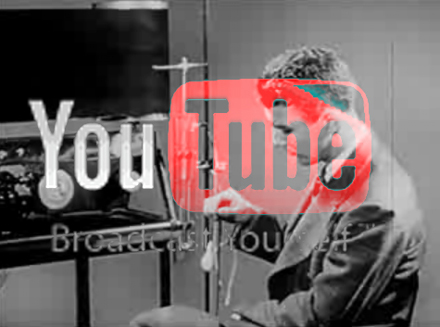The great collage artist and accidental avant-garde father of found-footage, Bruce Conner died July 7th 2008. His legacy in Library of Congress and in collections among major art institution the world over. But long before he certainly had been immortalized on YouTube, and that of course bears an amusing double-irony. Some might interpret it as "giving back" others as "stealing from a thief".

You Tube, the endless archive of moving imagery makes the access and findings of found footage so easy and so ordinary that the next generation wouldn't have bothered to acknowledge it as a particular genre of film making under this name.
To get an idea what YouTubers have to say about Conner, you only have to check out the bizarre comments followed by Conner's Devo video "Mongoloid"
One can find a good third of his body of work here, for instance the wonderful, melancholic "Valse Triste" (1977), a dreamy, sepia-tinted childhood story from the 40s.
To my surprise his seminal work, "A movie" (1958) is absent, but certainly online elsewhere, i.e. on this blog of an Italian film enthusiast, that proudly mentioned that he "ripped it from a VHS" and then posted a big banner, "SUPPORT CREATIVE COMMONS" (sic!) right above the movie window.
As for copyright questions, there had been an incient on YouTube with Conner, at least according to the detailed description of a YouTube subscriber, squeezed into a dozen of comment boxes. (which are limited to 500 characters) This incident occurred with Connor's film "Take the 5:10 to Dreamland"(1977)", "published without the artist's permission" Unclear remains who posted and who removed, however, the subscriber, Mark Charles Brown, made a highly interesting homage to this Conner film, which he named "Erasing Dreamland (Accidentally Erased Bruce Conner)". Searching through YouTube's meta data, he collected alternative clips depicting the same objects or similar imagery as in Conner's film and then juxtaposing them with the original.
This is where the copyright dispute on a Found Footage art piece in the digital mix'n'mash
world creates its own feedback: According to You Tube's Terms of Use agreement, the creator "hereby grants each user of the YouTube website permission [..] to use, reproduce, distribute, prepare derivative works..", as Brown quotes. After all, he lifted all the content from YouTube before Connor's piece was removed, then mixed with other YouTube content.
As in the spirit of found footage, Conner's obituary text should be Frankensteined from many existing ones of others, (which might be the case for many writers of such content?) however, here is Ken Johnson's from the NYT. who wrote an appropriate article, pointing out that there was another Bruce Conner beside the film maker. There is the beatnik, the sculptor and the outside-art artist whose oeuvre remained widely underexposed, until in the most recent years.
| Attachment | Size |
|---|---|
| conner2.jpg | 110.81 KB |
copyright holders
This is the sticky part of the copyright mess. Just like Guy Debord's widow didn't like Alex Galloway using her late husband's war games (See http://post.thing.net/node/2026). There's got to be an homage/snippet/ fair use part that allows fans and other working artists a chance to show/talk about what inspires them about another artists work
I haven't thought about Bruce Conner or any of the post war experimental US filmmakers in years. Kasbah's article spurred me to investigate. There must be a way to recognize economies of scale and understand that avant-garde art shouldn't be in the same category as Hollywood and Disney.
This does point out that in our commodity society if you think you have a "hot property" you want to protect it. This is the result of having a system that doesn't nuture experimental creativity but only honors limited supply and mass appeal.
http://nujus.net/~gh